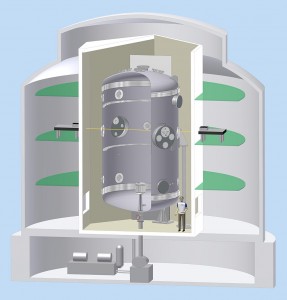16 October 2013
Making Martian clouds on Earth

Scientists recreated Martian cloud formation in the three-story cloud chamber at the Karlsruhe Institute of Technology in Germany. Previously only smaller, tabletop experiments had been conducted. Credit Karlsruhe Institute of Technology
If you want to understand the atmosphere of a planet, it helps to think big. That’s just what climate scientist Dan Cziczo and his colleagues did recently when they created conditions in the world’s largest cloud chamber mimicking those in the thin veil of gases that surrounds Mars.
Experiments by the researchers within the three-story shell of a former nuclear reactor in Karlsruhe, Germany have confirmed earlier runs in tabletop setups that have shown how the most common clouds on Mars form. Those ordinary occupiers of the Martian atmosphere resemble cirrus clouds on Earth.
By using a larger cloud chamber, researchers can add greater authenticity to their faux Mars atmospheres, enabling them to recreate large-scale pressure differences found where Martian clouds form.
With that added realism, Cziczo said, the team will set its sights on a rarer type of Martian cloud unlike any on Earth and which scientists know very little about – clouds of frozen carbon dioxide, otherwise known as “dry ice.”
“You can’t learn about Martian clouds by just extrapolating what we know about the Earth’s atmosphere,” explained Cziczo, who is at the Massachusetts Institute of Technology (MIT) and typically studies Earth’s clouds. “It really is a different regime, a different set of conditions.”
Studying Mars’ clouds provides important insight into the planet’s water cycle, yielding clues of the planet’s potentially wetter and more habitable past, according to Cziczo. The results of the recent tests were published last month in the Journal of Geophysical Research: Planets, a publication of the American Geophysical Union. Cziczo is first author of the study.
To mimic the unearthly Martian environment, Cziczo and his team filled the cloud chamber with pure nitrogen gas rather than air. While carbon dioxide composes 96 percent of the Martian atmosphere, the scientists opted for nitrogen instead to prevent any accidental gas leaks from turning deadly and suffocating the researchers. Cziczo said the most difficult challenge was dropping the chamber’s temperature down to the frigid temperatures on Mars.
“For the Earth’s atmosphere there’s not a lot of reason to go below 200 kelvins (minus 100 degrees Fahrenheit),” said Cziczo. “For this study we were really pushing things; we had to beef up the refrigeration system just to push it down to 185 Kelvin (minus 127 degrees Fahrenheit).”

A diagram of the cloud chamber used to recreate Martian cloud formation. The yellow line in the middle of the chamber represents a laser used to measure the newly formed clouds. The cavity is too dark to see into and any lights would heat up the chamber, ruining the test. Credit: Karlsruhe Institute of Technology
After chilling the clouds chamber, Cziczo pumped up the humidity in the chamber. Earthly clouds require less moisture in the air to form, but Cziczo said the lower temperatures in the Martian atmosphere require a higher relative humidity to spawn clouds. So he and his crew raised the relative humidity in their mega-cloud-chamber to 190 percent.
With the conditions for clouds finally optimal, only one last component was needed: a seed. Cloud seeds are tiny bits of material which provide a surface for water vapor to condense onto. Martian cloud seeds are almost always surface dust, Cziczo said. While no Martian dust has been brought back to Earth, Martian rovers have learned enough about those particles for scientists to find Earth-based substitutes. In this case, the team used mineral dust seeds from the Mojave Desert that are extremely small—just 1 micron (a millionth of a meter) across. Cziczo described the seeds as similar in consistency to the flour or powdered sugar commonly found in pantries.
After adding the cloud seed to the chamber, the researchers finally saw their clouds form. The new results, Cziczo said, will improve modeling of Mars’ atmosphere.
– Thomas Sumner is AGU’s science writing intern
Daniel J. Cziczo, Sarvesh Garimella, Michael Raddatz, Kristina Hoehler, Martin Schnaiter, Harald Saathoff, Ottmar Moehler, Jonathan P. D. Abbatt, & Luis A. Ladino (2013). Ice nucleation by surrogates of Martian mineral dust: What can we learn about Mars without leaving Earth? Journal of Geophysical Research: Planets : 10.1002/jgre.20155


 GeoSpace is a blog on Earth and space science, managed by AGU’s Public Information staff. The blog features posts by AGU writers and guest contributors on all sorts of relevant science topics, but with a focus on new research and geo and space sciences-related stories that are currently in the news.
GeoSpace is a blog on Earth and space science, managed by AGU’s Public Information staff. The blog features posts by AGU writers and guest contributors on all sorts of relevant science topics, but with a focus on new research and geo and space sciences-related stories that are currently in the news.